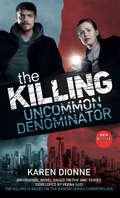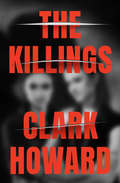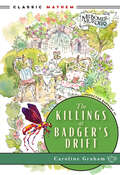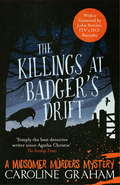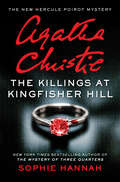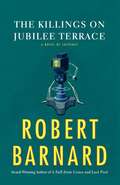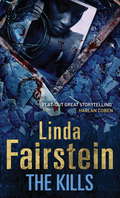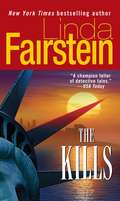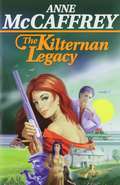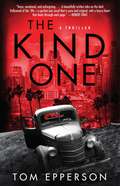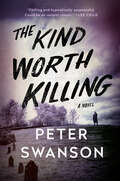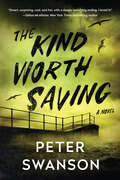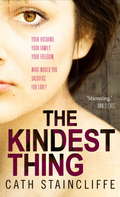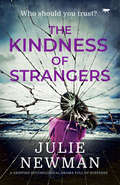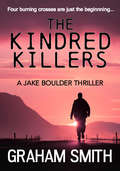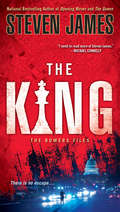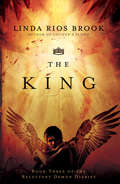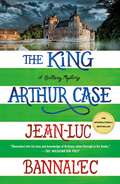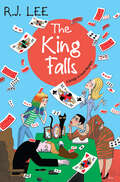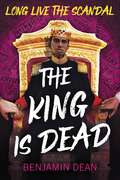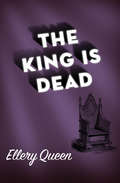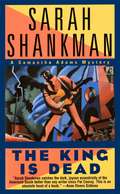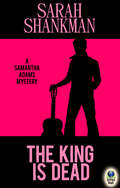- Table View
- List View
The Killing: Uncommon Denominator
by Karen DionneAn all-new crime novel featuring homicide detective Sarah Linden. <P><P>The Killing is based on the wildly successful Danish television series Forbrydelsen and tells the story of the murder of a young girl in Seattle and the subsequent police investigation. It ties together three distinct stories around a single murder including the detectives assigned to the case, the victim's grieving family, and the suspects. Set in Seattle, the story also explores local politics as it follows politicians connected to the case. As the series unfolds, it becomes clear that there are no accidents; everyone has a secret, and while the characters think they've moved on, their past isn't done with them. <P><P>Copyright © 2010-2013 AMC Network Entertainment LLC. All rights reserved.
The Killings
by Clark HowardTwo LAPD detectives are at odds over a horrifying case in this &“taut shocker&” of a novel by an Edgar Award–winning author (The Boston Globe). A pair of twins have been brutally murdered, and Los Angeles detectives George Cascade and Ed Fenner find themselves working a case with puzzling sexual overtones. When a young, intellectually disabled African American becomes the object of suspicion, tensions flare between the two officers—and it will push them to the edge before the truth can be sorted out. &“The kind of book you read at the point of a switchblade—seemingly faster than you can turn the pages.&” —Kirkus Reviews
The Killings at Badger's Drift: A Midsomer Murders Mystery 1 (Inspector Barnaby Mysteries #1)
by Caroline GrahamA quaint English village is home to a murderer in the Macavity Award-wining mystery series debut that launched the British crime drama Midsomer Murders.Badger’s Drift is the ideal English village, complete with vicar, bumbling local doctor, and kindly spinster. But when the spinster dies suddenly, her best friend kicks up a fuss loud enough to attract the attention of Detective Chief Inspector Barnaby. And when Barnaby and his eager-beaver deputy start poking around, they uncover a swamp of ugly scandals and long-suppressed resentments seething below the picture-postcard prettiness.In the grand English tradition of the quietly intelligent copper, Barnaby has both an irresistibly dry sense of humor and a keen insight into what makes people tick. The Killings at Badger’s Drift marks Inspector Barnaby’s debut, and offers ample proof that Caroline Graham may indeed be “simply the best detective writer since Agatha Christie” (Sunday Times of London).“Murder most pleasing . . . a corking good mystery.” —Los Angeles Times
The Killings at Badger's Drift: A Midsomer Murders Mystery 1 (Inspector Barnaby Mysteries Ser. #1)
by Caroline Graham'Simply the best detective writer since Agatha Christie' The Sunday TimesA book that will glue you from beginning to end. If you love Agatha Christie, you'll adore Caroline Graham, with characters who charm and murderers who terrorise. Named by the CWAs as one of 'The Top 100 Crime Novels of All Time', The Killings at Badger's Drift is the first spectacular novel in the Midsomer Murders series, the novel that inspired the ITV hit drama, now featuring an exclusive foreword by John Nettles who played best-loved TV detective and star of Midsomer Murders, DCI Tom Barnaby.The village of Badger's Drift is the essence of tranquillity. But when resident and well-loved spinster Miss Simpson takes a stroll in the nearby woods, she stumbles across something she was never meant to see, and there's only one way to keep her quiet.Miss Simpson's death is not suspicious, say the villagers. But Miss Lucy Bellringer refuses to rest: her friend has been murdered. She is sure of it.She calls on Detective Chief Inspector Barnaby to investigate, and it isn't long until the previously unseen seamy side of Badger's Drift is brought to light. But as old rivalries, past loves and new scandals surface, the next murder is not far away. Praise for Caroline Graham's novels:'One to savour' Val McDermid 'A mystery of which Agatha Christie would have been proud. . . A beautifully written crime novel' The Times'Tension builds, bitchery flares, resentment seethes . . . lots of atmosphere' Mail on Sunday'A witty, well-plotted, absolute joy of a book' Yorkshire Post 'Swift, tense and highly alarming' TLS 'Lots of excellent character sketches . . . and the dialogue is lively and convincing' Independent 'Read her and you'll be astonished . . . very sexy, very hip and very funny' Scotsman
The Killings at Badger's Drift: A Midsomer Murders Mystery 1 (Inspector Barnaby Mysteries Ser. #1)
by Caroline Graham'Simply the best detective writer since Agatha Christie' The Sunday TimesA book that will glue you from beginning to end. If you love Agatha Christie, you'll adore Caroline Graham, with characters who charm and murderers who terrorise. Named by the CWAs as one of 'The Top 100 Crime Novels of All Time', The Killings at Badger's Drift is the first spectacular novel in the Midsomer Murders series, the novel that inspired the ITV hit drama, now featuring an exclusive foreword by John Nettles who played best-loved TV detective and star of Midsomer Murders, DCI Tom Barnaby.The village of Badger's Drift is the essence of tranquillity. But when resident and well-loved spinster Miss Simpson takes a stroll in the nearby woods, she stumbles across something she was never meant to see, and there's only one way to keep her quiet.Miss Simpson's death is not suspicious, say the villagers. But Miss Lucy Bellringer refuses to rest: her friend has been murdered. She is sure of it.She calls on Detective Chief Inspector Barnaby to investigate, and it isn't long until the previously unseen seamy side of Badger's Drift is brought to light. But as old rivalries, past loves and new scandals surface, the next murder is not far away. Praise for Caroline Graham's novels:'One to savour' Val McDermid 'A mystery of which Agatha Christie would have been proud. . . A beautifully written crime novel' The Times'Tension builds, bitchery flares, resentment seethes . . . lots of atmosphere' Mail on Sunday'A witty, well-plotted, absolute joy of a book' Yorkshire Post 'Swift, tense and highly alarming' TLS 'Lots of excellent character sketches . . . and the dialogue is lively and convincing' Independent 'Read her and you'll be astonished . . . very sexy, very hip and very funny' Scotsman
The Killings at Kingfisher Hill: The New Hercule Poirot Mystery (Hercule Poirot Mysteries #04)
by Sophie Hannah“I was thrilled to see Poirot in such very, very good hands.”— Gillian Flynn, New York Times bestselling author of Gone GirlThe world’s greatest detective, Hercule Poirot—legendary star of Agatha Christie’s Murder on the Orient Express and Death on the Nile—returns to solve a delectably twisty mysteryHercule Poirot is traveling by luxury passenger coach from London to the exclusive Kingfisher Hill estate. Richard Devonport has summoned the renowned detective to prove that his fiancée, Helen, is innocent of the murder of his brother, Frank. Poirot will have only days to investigate before Helen is hanged, but there is one strange condition attached: he must conceal his true reason for being there from the rest of the Devonport family.The coach is forced to stop when a distressed woman demands to get off, insisting that if she stays in her seat, she will be murdered. Although the rest of the journey passes without anyone being harmed, Poirot’s curiosity is aroused, and his fears are later confirmed when a body is discovered with a macabre note attached . . .Could this new murder and the peculiar incident on the coach be clues to solving the mystery of who killed Frank Devonport? And if Helen is innocent, can Poirot find the true culprit in time to save her from the gallows?
The Killings on Jubilee Terrace
by Robert BarnardVernon Watts may have been beloved by the millions of faithful viewers of the long-running soap opera Jubilee Terrace but his fellow cast members knew him for what he was -- an egotistical former music-hall performer whose untimely death in a pedestrian accident was not something to be universally regretted. Sadly, though, director Reggie Friedman soon fills the supposed void by asking Hamish Fawley, an equally unpleasant former member of the Jubilee Terrace troupe, to rejoin the soap. Hamish was never much liked. Now he's more obnoxious than ever. The mood on the set is not exactly serene, a situation made worse when the police receive an anonymous letter suggesting that Vernon Watts's "accident" may in fact have been murder. Did one of his fellow actors push Vernon into the oncoming traffic? Detective Inspector Charlie Peace faces tough challenges as he probes the make-believe world of skilled thespians to find a possible killer. With a cast of suspects who are trained to emote on cue, Charlie will need all of his policeman's instincts if he's to avert further tragedy. Writing with his usual acerbic wit and penetrating insight into human foibles, acclaimed master of mystery Robert Barnard gives us another winning entry in his magnificent body of work.
The Kills: A Novel (Alexandra Cooper #6)
by Linda FairsteinPaige Vallis claimed that she gave in to Tripping's sexual demands because he had threatened to harm his son if she didn't. Alexandra Cooper, prosecuting the ex-CIA man, knew she had her work cut out to convince the jury, but before Paige could complete her testimony on the stand she is found dead - strangled in her own apartment building, just hours after she'd confessed to Alex that she had had a relationship with another ex-CIA operative. While the accusation of rape against Tripping is dropped, he has other charges to face, not least abusing his own child. As Tripping's defence team go into overdrive to keep their client out of jail, Alex, Chapman and Mercer set out to discover who so conveniently killed the woman who could have put him behind bars. As they peel back the layers of Paige's life, they discover a decades-old viper's nest of robbery and double-dealing and discover that truth of the adage of money being at the root of all evil - however old and 'respectable' it might be.
The Kills: A Novel (An Alexandra Cooper Novel #6)
by Linda FairsteinManhattan Assistant D.A. Alexandra Cooper is working feverishly on a tough trial, seeking justice for investment banker Paige Vallis. But in a heated "he said, she said" case, Alex learns that Paige herself has something to hide. Uptown, the murder of an elderly woman with an intriguing past has NYPD officer Mercer Wallace and detective Mike Chapman hunting for an item of stunning value that may have cost McQueen Ransome her life: a legendary Double Eagle gold coin. The twisting threads of the seemingly unrelated tragedies soon entangle Alex in a life-and-death struggle in the watery inlets of New Jersey known as the Kills...where a violent predator is determined to silence her forever.
The Kilternan Legacy
by Anne MccaffreyIrene Teasey came to Ireland to claim an unexpected interitance from an aunt she had never met . . . a legacy of land, a sprawling house, cottages with tenants, and even a horse . . . more than she had dared hope for. Enough to make her independent of her former husband. Enough to start a new life. Together with her children, Simon and Sara, she will find more than escape from an abusive relationship. She will find loyal friends, her extended Irish family . . . and a new love in this beautiful, ancient land.
The Kind One
by Tom EppersonIn the kill-or-be-killed criminal underworld of 1930s Los Angeles, "Two Gun Danny" Landon has a distinct disadvantage. According to the fellas, he used to pull all kinds of shoot-ups and shenanigans...but damned if he can't remember a thing from before last year, when he got hit over the head with a lead pipe. Sadistic mobster Bud Seitz -- known to friends and enemies alike as "The Kind One" -- seems to have big plans for him, but truthfully, Danny can't stomach the dirty work. His aim is off, the other wiseguys laugh at him, and he'd gladly trade in the drunken parties and the endless broads for a day at the movies with his colorful and mysterious neighbor Dulwich and eleven-year-old Sophie, whose deadbeat mother delivers an endless stream of emotional and physical abuse. But when Bud's beautiful girlfriend Darla begs Danny to help her escape the Kind One's dark, brutal world, Danny must confront a dangerous test of loyalty that could irrevocably change his future -- and his past -- forever.
The Kind Worth Killing: A Novel
by Peter SwansonA dark and devious literary suspense novel about a random encounter, sex, and a conversation that quickly turns to murder--a modern reimagining of Patricia Highsmith's classic Strangers on a Train--from the author of the acclaimed The Girl with a Clock for a HeartOn a late flight from London to Boston, Ted Severson meets the stunning and mysterious Lily Kintner. Over one too many martinis, the two strangers play a game, one in which they begin revealing more and more intimate details about themselves. Ted talks about his wife, Miranda--how his marriage has gone stale, how a week ago he caught her in a serious betrayal. . . . Maybe they were a mismatch from the start, he the rich businessman, she the beautiful artist. But what begins as playful banter between Ted and Lily takes a swift turn when Ted claims, half-seriously, that he would like to kill his wife for what she's done. Then Lily surprises him by saying that she'd like to help. After all, everyone dies, what difference does it make if a few bad apples get pushed along a little sooner than life intended?Back in Boston, Ted and Lily forge an unusual bond and talk about the ways Ted might get out of his marriage. But Lily has her own dark history she's not sharing with Ted, a legacy of murder that stems from childhood. And Ted is keeping something from Lily as well--so as they move their plan forward, his motivation becomes less about getting Miranda out of his life and more about getting Lily into it. But as Ted begins to fall in love with Lily, he grows anxious about any unseen holes in their scheme that could give them away. And suddenly the two are pulled into a very lethal game of cat and mouse, one in which there may be more than one loser and more than one of them left dead when it's all over.
The Kind Worth Saving: A Novel
by Peter Swanson“The inventive Mr. Swanson never lets the willing reader down. With The Kind Worth Saving, he surpasses his own high standard.” — Tom Nolan, Wall Street JournalIn this spectacularly devious novel by New York Times bestselling author Peter Swanson, a private eye starts to follow a possibly adulterous husband, but little does he know that the twisted trail will lead back to the woman who hired him.There was always something slightly dangerous about Joan. So, when she turns up at private investigator Henry Kimball’s office asking him to investigate her husband, he can’t help feeling ill at ease. Just the sight of her stirs up a chilling memory: He knew Joan in his previous life as a high school English teacher, when he was at the center of a tragedy.Now Joan needs his help proving that her husband is cheating. But what should be a simple case of infidelity becomes much more complicated when Kimball finds two bodies in an uninhabited suburban home with a FOR SALE sign out front. Suddenly it feels like the past is repeating itself, and Henry must go back to one of the worst days of his life to uncover the truth.Is it possible that Joan knows something about that day, something she’s hidden all these years? Could there still be a killer out there, someone who believes they have gotten away with murder? Henry is determined to find out, enlisting help from his old nemesis Lily Kintner—but as he steps closer to the truth, a murderer is getting closer to him, and in this hair-raising game of cat and mouse only one of them will survive.
The Kindest Thing
by Cath StaincliffeA love story, a modern nightmare and an honest and incisive portrayal of a woman who honours her husband's wish to die and finds herself in the dock for murder.When Deborah reluctantly helps her beloved husband Neil end his life and conceals the truth, she is charged with murder. As the trial unfolds and her daughter Sophie testifies against her, Deborah, still reeling with grief, fights to defend her actions. Twelve jurors hold her fate in their hands, if found guilty she will serve a life sentence. Deborah seeks solace in her memories of Neil and their children and the love they shared. An ordinary woman caught up in an extraordinary situation.A finely written page-turner, compelling, eloquent, heart-breaking. The Kindest Thing tackles a controversial topic with skill and sensitivity. A book that begs the question: what would you do?
The Kindest Thing
by Cath StaincliffeA love story, a modern nightmare and an honest and incisive portrayal of a woman who honours her husband's wish to die and finds herself in the dock for murder.When Deborah reluctantly helps her beloved husband Neil end his life and conceals the truth, she is charged with murder. As the trial unfolds and her daughter Sophie testifies against her, Deborah, still reeling with grief, fights to defend her actions. Twelve jurors hold her fate in their hands, if found guilty she will serve a life sentence. Deborah seeks solace in her memories of Neil and their children and the love they shared. An ordinary woman caught up in an extraordinary situation.A finely written page-turner, compelling, eloquent, heart-breaking. The Kindest Thing tackles a controversial topic with skill and sensitivity. A book that begs the question: what would you do?
The Kindness of Strangers: A Gripping Psychological Drama Full of Suspense
by Julie NewmanThis novel about the dark past that haunts a seemingly happy household is “an intricate portrayal of love and loss, redemption and revenge” (Anne Coates, author of Songs of Innocence).Helen, a widow, is desperate for a perfect family life and will do everything she can to get what she wants.Martin, a veteran, is adrift and seemingly without hope. Can he ever win back his estranged family?Charley, a pregnant teenager, is striking out on her own to create a new life for her unborn child—but her mother has other ideas.When these three seemingly disparate lives connect, the past and the present collide to reveal secrets, lies, and just how far people are willing to go to hide the truth . . .
The Kindred Killers (The Jake Boulder Thrillers #2)
by Graham Smith&“A new tough guy to root for . . . a hero who is as sharp with his wits, and his tongue, as he is with his fists.&” —Matt Hilton, bestselling author of the Joe Hunter novels After a family of four is crucified and burned alive, Jake Boulder is determined to help out his best friend and sometime-employer, a private detective related to the victims. But as Boulder tries to track the heinous killer, a young woman is abducted and found dead—and Boulder realizes these murders have something unusual in common. With virtually no leads for Boulder to follow, he strives to find a clue to the killer&’s identity, but he&’s not even sure if he&’s hunting for one perpetrator or more. Then, after a young couple is snatched in the middle of the night, the FBI comes to Colorado to help with the case and Boulder is warned off. Still, he feels he has no choice but to press on when incendiary mobile-phone footage is sent to every major US news outlet—though it won&’t be easy with the authorities against him—in this intense crime thriller by a #1 bestselling author.
The King
by Steven JamesSettling into a new post at the FBI academy, Patrick Bowers and his fiance Lien-hua Jiang are planning their future together with Patrick's stepdaughter, Tessa. But just when his life seems normal, a demon from the past returns to draw him down a dark road he hoped had closed forever. Forced into a desperate hunt to save the two women he loves most, Patrick is in a race against time to stop an international conspiracy from becoming the most widespread act of terrorism in U. S. history.
The King (The Reluctant Demon Diaries #3)
by Linda Rios BrookAncient language expert Samantha Yale returns to translate a new batch of scrolls written by the fallen angel from Lucifer’s Flood. Samantha Yale has taken on a daunting translation project. A set of scrolls, delivered by a man she knows nothing about, tells a fascinating and frightening tale of what went on behind the scenes of biblical history. What is even more incredible is who is telling the tale--a fallen angel who immediately regretted his decision to side with Lucifer. In book three of The Reluctant Demon Diaries series, we find that the mysterious Wonk Eman has disappeared. Fearing the remaining scrolls may be lost forever, Samantha is determined to find him. Her search leads her an old church where she finds Wonk and convinces him that he must overcome his fear and allow her to examine the remaining scrolls. This new volume of writings begins with the time of the judges over Israel as the nameless angel continues to watch and report to Satan on the progress of humanity as God leads them forward through the reign of King David.
The King Arthur Case: A Brittany Mystery (Brittany Mystery Series #7)
by Jean-Luc BannalecThe King Arthur Case is the seventh installment of Jean-Luc Bannalec's bestselling mystery series.The forest of Broceliande, with its picturesque lakes and castles, is the last remnant of the fairy kingdom, if Breton lore is to be believed. Innumerable legends spanning thousands of years are set here, inclding the tale of King Arthur and the Round Table.It seems to be an appropriate destination for Commissaire Dupin and his team to take a late summer field trip. But when the body of a historian turns up, Dupin is called upon to investigate in the brutal murder case. Before too long, there are more victims. What knowledge do the assembled scientists have about the most recent archaeological digs in the area? Where do they stand on the controversial decision to turn parts of the forest into an amusement park? And why is no one willing to talk? Even Nolwenn, Dupin's unshakeable assistant, is concerned. And that means trouble.Mysterious, ingenious, and suspenseful: Dupin's seventh case takes him and his team into the very heart of Brittany.
The King Falls (A Bridge to Death Mystery #4)
by R.J. LeeIt&’s up to reporter and bridge player Wendy Winchester Rierson to finesse a homicide investigation where the killer holds a master hand . . . King Kohl, scion of the Kohl and Son real estate firm, has a reputation for loving three things: the ladies, closing on properties, and playing bridge. Still, when he invites Wendy, the president of the Rosalie, Mississippi, Country Club Bridge Bunch, to a small, exclusive bridge party, her investigative instincts as a reporter for the Rosalie Citizen are on the alert. In fact, King means to use the occasion to make a surprising announcement to his selected guests. But before he can lay his cards on the table, tragedy strikes. After receiving a mysterious message to hurry to King&’s home, Wendy almost collides with the man&’s real-estate rival, running out the front door insisting he found King dead when he arrived. Not just dead, it turns out, but murdered—crowned with one of his own award plaques. Is the rival as guilty as he looks? Was it a crime of passion by one of Kohl&’s scorned lovers? With her detective husband Ross and her father Bax Winchester, the chief of police, Wendy is determined to find the offender who dropped the unguarded King . . . Praise for Cold Reading Murder &“A very Southern mystery with authentic characters, a well-hidden killer, and some helpful bridge tips.&” —Kirkus Reviews
The King Is Dead
by Benjamin DeanIn this romantic thriller perfect for fans of Ace of Spades, James—the shy, handsome, mixed-race heir to the British throne—must choose between love and duty amidst a dangerous scandal and a tabloid media desperate for his downfall. Heavy is the crown James has been born to wear, especially as the first Black heir to the British throne. But with his father&’s recent passing, and with a new secret boyfriend, James is woefully unprepared for the sudden shine of public scrutiny. When his secrets come spilling forth across tabloid pages and the man he thought he loved has suddenly disappeared, James finds himself on the precipice of ruin. As every detail of his life becomes public knowledge, his sense of safety is shattered and the people he trusts the most become the likeliest suspects. What dangers lurk behind the palace walls—and will the new king find out before it&’s too late?
The King Is Dead (G. K. Hall Paperback Ser.)
by Ellery QueenEllery Queen and his father discover a baffling murder on a private island Ellery Queen and his father are meandering through breakfast when their apartment is invaded. Without making a sound, 2 men appear in the Queens&’ living room, guns drawn, and proceed to search the place. When they&’re done, a 3rd man follows: a paunchy little professor-type who happens to be the brother of a king. King Bendigo doesn&’t rule a country, but his control of the international arms trade has made him one of the richest men in the world. It&’s not surprising that somebody wants him dead. Bendigo&’s brother comes to the Queens to ask them to save the tycoon&’s life—but they fail. The king is found dead in a hermetically sealed room, a bullet lodged in his heart. The murder is impossible to solve—that is, for anyone but Ellery Queen.
The King Is Dead (Samantha Adams #5)
by Sarah ShankmanIn her witty, southern-fried suspense novels, Sarah Shankman delivers nonstop action with a hilarious bite. Now she sends her acclaimed, irreverent heroine -- New Orleans writer Samantha Adams -- to a southwestern New Age hot spot, to unearth a secret past that was supposed to be six feet under. My dearest Sugar. I must see you. It's urgent. I need your help. The letter that arrived from Sam's mother was postmarked Santa Fe, penned in her mother's handwriting, and disclosed details only Johanna Adams could know. There was just one catch: Johanna Adams had been dead for thirty-four years. The mind-blowing missive could have been an entry from Sam's latest book of bizarre anecdotes, American Weird -- or an elaborate hoax. Either way, it instantly rekindled Sam's impossible wish that her mother hadn't really died in a plane crash when Sam was a child. Fueled by her journalistic instincts -- and a daughter's need for closure -- Sam touches down among Santa Fe's tourists and crystal gazers, jewelry shops and fast-food stands. But only when she summons the courage to knock on the door of Room 409 at the La Fonda Hotel does her surreal, mother-seeking adventure take off with no turning back.
The King Is Dead (The Samantha Adams Mysteries #5)
by Sarah ShankmanThings get weirder than a peanut butter and banana sandwich when crime reporter Samantha Adams visits Elvis&’s birthplace in this Southern mystery. Crime reporter Samantha Adams is working on a book called American Weird when her boyfriend, Harry, invites her to a barbecue cookoff in Tupelo, Mississippi. It&’s hard to turn down a drive to Elvis&’s birthplace in a genuine pink Cadillac. And as Harry points out, the King&’s birthplace &“ought to be lousy with weird.&” As they soon discover, lousy is right—and weird is just the beginning. Also visiting Tupelo is Mary Ann McClanahan. After killing her worthless husband, Carlin, she discovered he was already married to a woman in Tupelo who&’ll collect his life insurance—unless she does something about it. Meanwhile, the cookoff heats up when a contestant is zapped by his own electric smoker, and Samantha&’s dog has to be rescued by a Biker for Jesus at the Elvis Memorial McDonald&’s. But when Lovie Rakestraw, one of Elvis&’s junior high classmates, is found electrocuted in her whirlpool, Sam is on the killer&’s trail like a hound dog.
